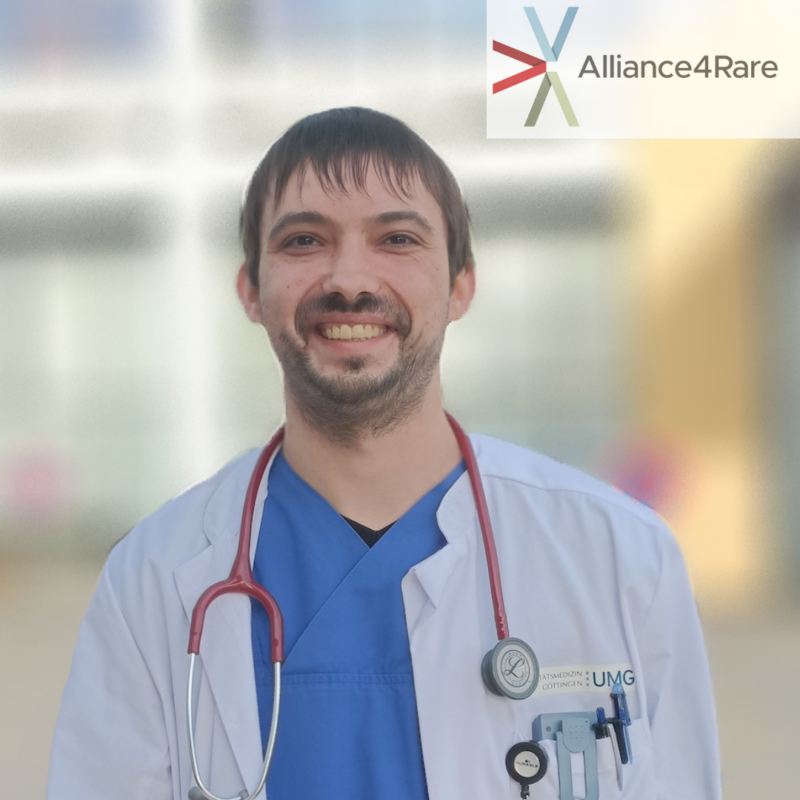Rare diseases affect children and adolescents in eight out of ten cases. Their participation in medical progress therefore depends crucially on dedicated pediatricians who are committed to the balancing act between bedside and laboratory. The Alliance4Rare research network initiated by the Eva Luise and Horst Köhler Foundation provides structured Clinician and Medical Scientist Programs (CS4RARE) to prepare researching paediatricians for this challenging task and to give them the necessary freedom for scientific work at a high level. The programs grant participants protected research periods in which they are released from clinical duties to advance scientific projects on rare diseases.
Dr. Badura, you have been selected for the Alliance4Rare Clinician Scientist Program. What was your motivation to pursue this particular path in science and clinical practice?
In university medicine, we have frequent contact with children and adolescents with rare and complex diseases. Thanks to the constantly improving diagnostic possibilities, we are more and more able to put a name to previously unclear diseases. This often helps the affected families to cope better with the disease.
A major goal for the future of pediatrics is to develop treatment strategies and to be able to provide patients with personalized help. To do so, it is necessary to understand the pathophysiological basis of rare diseases. The Clinician Scientist Program of the Alliance4Rare is a unique opportunity to combine clinical work and research for rare diseases in everyday working life.
What are you currently working on and what would you like to achieve?
Alternating Hemiplegia of Childhood (AHC), Rapid-Onset Dystonia-Parkinsonism (RDP, DYT12) and CAPOS syndrome (cerebellar ataxia, areflexia, pes cavus, optic atrophy, sensorineural hearing loss) belong to a group of rare neurological diseases caused by mutations in the ATP1A3 gene.
There are currently no causal therapies for any of these diseases, and patients suffer from a variety of painful symptoms and have to endure repeated stressful diagnostic procedures. The aim of my research project is to use state-of-the-art 3D cell culture models (bioengineered neuronal organoids (BENOs)) from human stem cells to identify the underlying pathophysiology of the respective disease entity and to develop therapeutic options for the patients.
With our research, we aim to help improve the care and thus the quality of life of these patients and spare them stressful examinations.
What opportunities does the funding from the Alliance4Rare Clinician Scientist Program open up for you in your day-to-day work that you would not have otherwise?
In our everyday clinical work, we often deal with the optimization of therapies for rare neurological diseases. Thanks to the Alliance4Rare funding, I have the opportunity to contribute to the understanding of such diseases in addition to my clinical work. In the future, it will hopefully be possible to translate these findings into new therapeutic options for patients and improve their quality of life. Without such funding, it would not be possible to carry out such time-consuming research projects.
We also hope to gain a better understanding of the basic pathomechanisms behind the symptoms so that we can also help patients with other diseases. In this way, research into rare diseases can lead to better treatment also of common diseases.
Dr. Simon Badura studied human medicine at the Georg-August-University Göttingen. As part of an experimental doctoral thesis at the Göttingen Neuroanatomy Department, he focused on brain research and also worked in the PD Dreha-Kulaczewski research group, where he investigated cerebrospinal fluid flow in the central nervous system using real-time MRI studies. He is expected to complete his training as a specialist in pediatrics and adolescent medicine in the Department of Pediatrics at the University Medical Center Göttingen in 2023 and will then begin his specialist training in neuropaediatrics.



